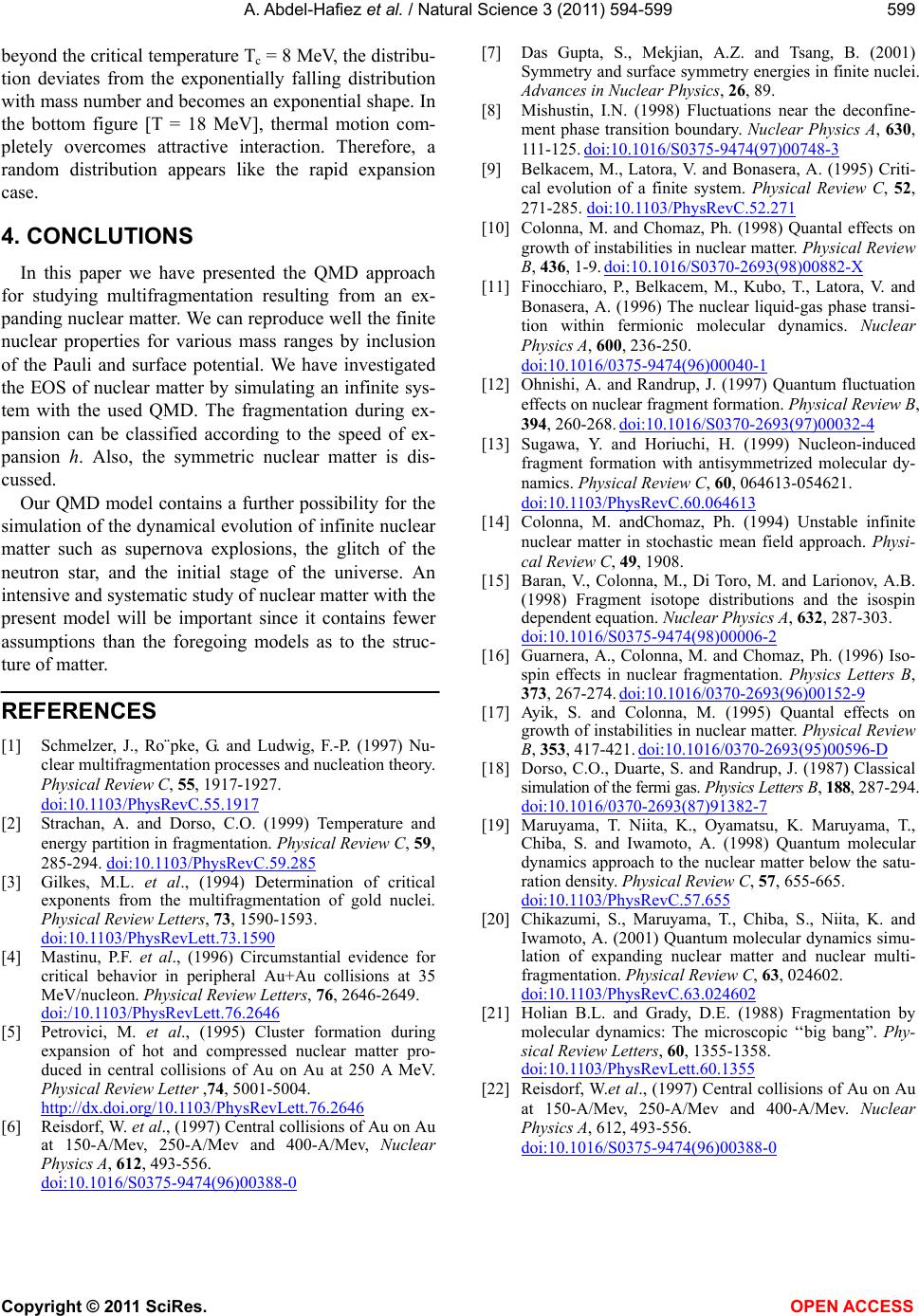
A. Abdel-Hafiez et al. / Natural Science 3 (2011) 594-599
Copyright © 2011 SciRes. OPEN ACCESS
599
beyond the critical temperature Tc = 8 MeV, the distribu-
tion deviates from the exponentially falling distribution
with mass number and becomes an exponential shape. In
the bottom figure [T = 18 MeV], thermal motion com-
pletely overcomes attractive interaction. Therefore, a
random distribution appears like the rapid expansion
case.
4. CONCLUTIONS
In this paper we have presented the QMD approach
for studying multifragmentation resulting from an ex-
panding nuclear matter. We can reproduce well the finite
nuclear properties for various mass ranges by inclusion
of the Pauli and surface potential. We have investigated
the EOS of nuclear matter by simulating an infinite sys-
tem with the used QMD. The fragmentation during ex-
pansion can be classified according to the speed of ex-
pansion h. Also, the symmetric nuclear matter is dis-
cussed.
Our QMD model contains a further possibility for the
simulation of the dynamical evolution of infinite nuclear
matter such as supernova explosions, the glitch of the
neutron star, and the initial stage of the universe. An
intensive and systematic study of nuclear matter with the
present model will be important since it contains fewer
assumptions than the foregoing models as to the struc-
ture of matter.
REFERENCES
[1] Schmelzer, J., Ro¨pke, G. and Ludwig, F.-P. (1997) Nu-
clear multifragmentation processes and nucleation theory.
Physical Review C, 55, 1917-1927.
doi:10.1103/PhysRevC.55.1917
[2] Strachan, A. and Dorso, C.O. (1999) Temperature and
energy partition in fragmentation. Physical Review C, 59,
285-294. doi:10.1103/PhysRevC.59.285
[3] Gilkes, M.L. et al., (1994) Determination of critical
exponents from the multifragmentation of gold nuclei.
Physical Review Letters, 73, 1590-1593.
doi:10.1103/PhysRevLett.73.1590
[4] Mastinu, P.F. et al., (1996) Circumstantial evidence for
critical behavior in peripheral Au+Au collisions at 35
MeV/nucleon. Physical Review Letters, 76, 2646-2649.
doi:/10.1103/PhysRevLett.76.2646
[5] Petrovici, M. et al., (1995) Cluster formation during
expansion of hot and compressed nuclear matter pro-
duced in central collisions of Au on Au at 250 A MeV.
Physical Review Letter ,74, 5001-5004.
http://dx.doi.org/10.1103/PhysRevLett.76.2646
[6] Reisdorf, W. et al., (1997) Central collisions of Au on Au
at 150-A/Mev, 250-A/Mev and 400-A/Mev, Nuclear
Physics A, 612, 493-556.
doi:10.1016/S0375-9474(96)00388-0
[7] Das Gupta, S., Mekjian, A.Z. and Tsang, B. (2001)
Symmetry and surface symmetry energies in finite nuclei.
Advances in Nuclear Physics, 26, 89.
[8] Mishustin, I.N. (1998) Fluctuations near the deconfine-
ment phase transition boundary. Nuclear Physics A, 630,
111-125. doi:10.1016/S0375-9474(97)00748-3
[9] Belkacem, M., Latora, V. and Bonasera, A. (1995) Criti-
cal evolution of a finite system. Physical Review C, 52,
271-285. doi:10.1103/PhysRevC.52.271
[10] Colonna, M. and Chomaz, Ph. (1998) Quantal effects on
growth of instabilities in nuclear matter. Physical Review
B, 436, 1-9. doi:10.1016/S0370-2693(98)00882-X
[11] Finocchiaro, P., Belkacem, M., Kubo, T., Latora, V. and
Bonasera, A. (1996) The nuclear liquid-gas phase transi-
tion within fermionic molecular dynamics. Nuclear
Physics A, 600, 236-250.
doi:10.1016/0375-9474(96)00040-1
[12] Ohnishi, A. and Randrup, J. (1997) Quantum fluctuation
effects on nuclear fragment formation. Physical Review B,
394, 260-268. doi:10.1016/S0370-2693(97)00032-4
[13] Sugawa, Y. and Horiuchi, H. (1999) Nucleon-induced
fragment formation with antisymmetrized molecular dy-
namics. Physical Review C, 60, 064613-054621.
doi:10.1103/PhysRevC.60.064613
[14] Colonna, M. andChomaz, Ph. (1994) Unstable infinite
nuclear matter in stochastic mean field approach. Physi-
cal Review C, 49, 1908.
[15] Baran, V., Colonna, M., Di Toro, M. and Larionov, A.B.
(1998) Fragment isotope distributions and the isospin
dependent equation. Nuclear Physics A, 632, 287-303.
doi:10.1016/S0375-9474(98)00006-2
[16] Guarnera, A., Colonna, M. and Chomaz, Ph. (1996) Iso-
spin effects in nuclear fragmentation. Physics Letters B,
373, 267-274. doi:10.1016/0370-2693(96)00152-9
[17] Ayik, S. and Colonna, M. (1995) Quantal effects on
growth of instabilities in nuclear matter. Physical Review
B, 353, 417-421. doi:10.1016/0370-2693(95)00596-D
[18] Dorso, C.O., Duarte, S. and Randrup, J. (1987) Classical
simulation of the fermi gas. Physics Letters B, 188, 287-294.
doi:10.1016/0370-2693(87)91382-7
[19] Maruyama, T. Niita, K., Oyamatsu, K. Maruyama, T.,
Chiba, S. and Iwamoto, A. (1998) Quantum molecular
dynamics approach to the nuclear matter below the satu-
ration density. Physical Review C, 57, 655-665.
doi:10.1103/PhysRevC.57.655
[20] Chikazumi, S., Maruyama, T., Chiba, S., Niita, K. and
Iwamoto, A. (2001) Quantum molecular dynamics simu-
lation of expanding nuclear matter and nuclear multi-
fragmentation. Physical Review C, 63, 024602.
doi:10.1103/PhysRevC.63.024602
[21] Holian B.L. and Grady, D.E. (1988) Fragmentation by
molecular dynamics: The microscopic ‘‘big bang”. Phy-
sical Review Letters, 60, 1355-1358.
doi:10.1103/PhysRevLett.60.1355
[22] Reisdorf, W.et al., (1997) Central collisions of Au on Au
at 150-A/Mev, 250-A/Mev and 400-A/Mev. Nuclear
Physics A, 612, 493-556.
doi:10.1016/S0375-9474(96)00388-0